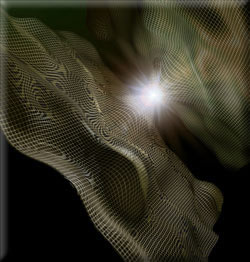Before the Big Bang
Cosmologists contend that what we think of as the moment of creation was simply part of an infinite cycle of titanic collisions between our universe and a parallel world
11.30.2006
By Michael D. Lemonick
Illustrations by Moonrunner Design
The Catholic Church, which put Galileo under house arrest for daring to say that Earth orbits the sun, isn't known for easily accepting new scientific ideas. So it came as a surprise when Pope Pius XII declared his approval in 1951 of a brand new cosmological theory—the Big Bang. What entranced the pope was the very thing that initially made scientists wary: The theory says the universe had a beginning, and that both time and space leaped out of nothingness. It seemed to confirm the first few sentences of Genesis.
Eventually, astrophysicists followed the pope's lead, as evidence for the Big Bang became too powerful to ignore. They accepted the notion that the entire observable universe—100 billion galaxies, each stuffed with 100 billion stars, stretching out more than 10 billion light-years in all directions—was once squashed into a space far smaller than a single electron. They bought the idea that the cosmos burst into existence precisely 13.7 billion years ago and has been expanding ever since. But even now, many astrophysicists are still uncomfortable with the implication that the Big Bang marked the beginning of time itself. And the theory has yet to yield a satisfactory answer to a key question: What made the Big Bang go bang?
 |
| What triggered the Big Bang? According to a new theory, our universe crashed into another three-dimensional world hidden in higher dimensions. "The model suggests a radically different view of cosmic history in which the key events shaping the structure of the universe occurred before the Big Bang," says cosmologist Paul Steinhardt. |
Cosmologists Paul Steinhardt and Neil Turok have a radical idea that could wipe away these mysteries. They theorize that the cosmos was never compacted into a single point and did not spring forth in a violent instant. Instead, the universe as we know it is a small cross section of a much grander universe whose true magnitude is hidden in dimensions we cannot perceive. What we think of as the Big Bang, they contend, was the result of a collision between our three-dimensional world and another three-dimensional world less than the width of a proton away from ours—right next to us, and yet displaced in a way that renders it invisible. Moreover, they say the Big Bang is just the latest in a cycle of cosmic collisions stretching infinitely into the past and into the future. Each collision creates the universe anew. The 13.7-billion-year history of our cosmos is just a moment in this endless expanse of time.
The hidden dimensions and colliding worlds in the new model are an outgrowth of superstring theory, an increasingly popular concept in fundamental physics. Scientists currently rely on two mutually incompatible theories—relativity and quantum mechanics—to describe the most massive objects in the universe on the one hand and subatomic particles on the other. For nearly a century, theorists have attempted to come up with a single model and a single set of equations that melds the two views of physics. Superstring theory is an evolving attempt to do just that: explain matter, energy, space-time, and the basic forces of nature in one framework.
String theory is hellishly complex. In order to make it work, theorists have to assume that space isn't merely three-dimensional, the way it appears to our puny human senses, but rather that it has up to 10 spatial dimensions. Just as a bedsheet hanging on a clothesline appears to be a two-dimensional object hanging in a three-dimensional world, all of space-time would be suspended in a higher-order space. In keeping with this two-dimensional analogy, string theorists describe our observable universe as a membrane—"brane" for short—flapping in the breezes of the actual 10-dimensional cosmos.
Physicists are just beginning to poke and prod at the big implications of superstring theory. That's what Burt Ovrut of the University of Pennsylvania was doing during a 1998 cosmology conference at the Newton Institute of Mathematical Sciences in Cambridge, England. He asked: If we live on a brane that's wafting through multidimensional space, why shouldn't there be other such branes floating around out there? Nothing in the theory ruled out this possibility. And if other branes exist, they could interact. It would be fascinating, Ovrut proposed during his talk, to consider what might happen if they did.
The idea intrigued Steinhardt, a professor at Princeton University who was sitting in the audience. If the interaction between branes was a collision, it would trigger a fantastically powerful reaction, Steinhardt guessed, given the immense amounts of matter and energy in each one. The crash would release so much energy, in fact, that it might be comparable to another energy release he was already quite familiar with: the Big Bang.
Meanwhile, Turok, a professor at Cambridge University, was sitting in the same audience having similar thoughts. After the lecture both men approached Ovrut to discuss their ideas. "It was clear that a collision of branes would be a dramatic event," Turok says. "People had talked about it in a mathematical way before, but nobody had thought of it as a real, physical process."
Steinhardt, Turok, and Ovrut, along with Steinhardt's graduate student Justin Khoury, decided to see what implications colliding branes might have for cosmology. They weren't driven by idle curiosity alone. Steinhardt, in particular, had been growing increasingly disenchanted with the conventional Big Bang model. The problem wasn't just that the theory required that time and space have a beginning but also that the more cosmologists tried to refine their model, the messier it seemed.
The original Big Bang model was simple: a hot dense knot of energy burst outward, congealed into matter, and kept expanding. But by the 1980s, astrophysicists had embraced a more complex elaboration of the Big Bang known as inflation.
Ironically, one of the theorists who developed this idea was Steinhardt. Inflation theory postulates that in the first hundred-millionth of a billionth of a billionth of a billionth of a second of its life, the universe expanded as though it were turbocharged, swelling much faster than the speed of light, before settling down to a more sedate rate of growth. The only way that could have happened is if there had been some incredible energy source pervading the newborn cosmos and blowing it apart. We don't see anything like that in the universe today, however, so cosmologists had to assume the potent energy field existed for only a fraction of a second after the Big Bang and then vanished.
Conjuring up new, unknown energy fields goes against both common sense and one of the most cherished scientific doctrines. A principle known as Occam's razor says the simplest possible explanation for natural phenomena is usually right. Perhaps the best-known example is the Earth-centered cosmology of Ptolemy, which dominated Western science for 1,000 years. When Ptolemaic theorists discovered that the planets did not appear to be moving in a simple pattern around Earth, they added epicycles—tiny circular movements on top of the grand orbital circles. Closer examination showed that this didn't quite explain observations either, so the theorists added epicycles on top of epicycles until the model did work. The final result was also very complex. Then Copernicus came along with the idea of a sun-centered cosmology, and Johannes Kepler realized that planets actually move in ellipses. Suddenly, planetary motions made sense without the complexity of epicycles, and the old theory was dropped.
Part 2 --> | 1, 2, 3
|

